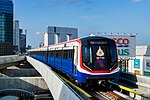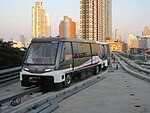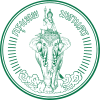History
Bangkok's first rail line was the private Paknam Railway linking Bangkok to Samut Prakan which opened in 1893. The national railway network was subsequently developed and first opened in 1896, linking Bangkok to Nakhon Ratchasima and then expanding to reach Chiang Mai, Nong Khai, Ubon Ratchathani and Su-ngai Kolok.
Electric trams served the city from 1894 to 1968. In the late 1800s and early 1900s, King Rama V eagerly built a tram network for Bangkok by employing foreign engineers and technicians, especially Danish engineers. However, due to a lack of interest and maintenance, the tram network was completely scrapped in 1968.
Although proposals for the development of rapid transit in Bangkok had been made since 1975, leading to plans for the failed Lavalin Skytrain, it was only in 1999 that Thailand's first rapid transit system, the BTS Skytrain, began operation.
The underground MRT subsequently opened in 2004, the Airport Rail Link began operation in 2010, and the SRT Red Lines began trial operation in 2021.
Inter-city and high-speed rail
Main article: State Railway of Thailand
Bangkok is the location of the Krung Thep Aphiwat Central Terminal, the central rail hub for most long-distance trains as of 2023, as well as the older Hua Lamphong station, both operated by the State Railway of Thailand (SRT). From Bangkok, trains travel on the Northern Line to Chiang Mai, the Northeastern Line to Nong Khai and Ubon Ratchathani, and the Eastern Line to Aranyaprathet, and the Southern Line, which terminates at Su-ngai Kolok and has a connection to Malaysia (the other Southern terminus is Thonburi).
High-speed rail
Main article: High-speed rail in ThailandThere are multiple planned high-speed rail lines in Thailand. The Bangkok–Nong Khai high-speed railway and Don Mueang–Suvarnabhumi–U-Tapao high-speed railway are under construction as of 2023. The Krung Thep Aphiwat Central Terminal will act as a future hub for all high-speed services.
Commuter Rail

In addition to long-distance services, the SRT also operates a few daily commuter trains running from and to the outskirts of the city, and the newer electrified SRT Red Lines.
Mass Rapid transit (Metro Train System) in Bangkok
Main article: Mass Rapid Transit Master Plan in Bangkok Metropolitan RegionBangkok is currently served by four rapid transit systems: the BTS Skytrain, the MRT, the Airport Rail Link, and the SRT Red Lines.
| System | Began operation | Lines in operation | Lengths in operation | Stations in operation | Operators |
|---|---|---|---|---|---|
| 1999 | 3 | 100 km (62.2 mi) | 63 | BTSC under concession from BMA | |
| [REDACTED] MRT | 2004 | 4 | 135.9 km (84.4 mi) | 107 | BEM (Blue Line and Purple Line)
Eastern Bangkok Monorail (Yellow Line) under concession from MRTA Northern Bangkok Monorail (Pink Line) under concession from MRTA |
| 2010 | 1 | 28.6 km (17.8 mi) | 8 | Asia Era One under concession from SRT | |
| SRT Red Lines | 2021 | 2 | 41 kilometres (25 mi) | 14 | SRT |
| Total | 10 | 275.55 km (171.22 mi) | 162 | ||

BTS Skytrain

The Skytrain consists of three lines, totalling 70.05 kilometers (43.53 mi): Sukhumvit Line running southwards from Khu Khot Station along Phahon Yothin Road and then eastwards along Sukhumvit Road to Kheha Station in Samut Prakan. The Silom Line runs eastwards from National Stadium Station in Pathum Wan District, then southwest along Ratchadamri, Si Lom, Narathiwat Ratchanakharin and Sathon Roads, crossing the Chao Phraya passing Wong Wian Yai Station in Khlong San towards Bang Wa Station in Phasi Charoen District. Both lines are elevated, and interchange at Siam Station in Pathum Wan. And Gold Line (Bangkok) which run along Charoen Nakhon in Khlong San from Krung Thon Buri Station that interchange with Silom Line to Khlong San Station at the end.
MRT (Metro)

The MRT system opened in July 2004, and currently consists of four lines, the Blue Line (partially underground heavy rail), Purple Line (above-ground medium capacity rail) and Yellow Line and Pink Line (monorail). The Blue Line runs for 37.1 kilometres (23.1 mi) from Tao Poon Station in a southward arc through the east along Ratchadaphisek Road, via Hua Lamphong, where it connects to the central railway station, to Lak Song. It has 38 stations, and connects to the BTS system at BTS stations Mo Chit, Asok, Sala Daeng and Bang Wa. The Blue Line was extended to form a circle in 2020. The Purple Line opened in 2016.
Although initial passenger numbers were low, these systems have become indispensable to many commuters. The BTS reported an average of 392,167 daily trips in 2010, while the MRT had 178,334 passenger trips per day. However, relatively high fare prices have kept these systems inaccessible to a portion of the population. The Pink and Yellow monorail lines opened in 2023.
Airport Rail Link
Main article: Airport Rail Link (Bangkok)The Airport Rail Link, opened in August 2010 after many delays, connects the city centre to Suvarnabhumi Airport in Samut Prakan Province to the east. It is operated by the SRT, and offers services between the airport and Makkasan where it connects with Phetchaburi Station of the MRT. It terminates at Phaya Thai Station, where it connects to the BTS. Its eight stations span a distance of 29 kilometres (18 mi).
SRT Red Lines
The Red Line Mass Transit System Project is a commuter rail system serving the Bangkok Metropolitan Region. Construction began in January 2009 and free public trial operation began on 2 August 2021, with full commercial service beginning on November 29, 2021 when Bang Sue Grand Station opened. It consists of two lines, the Dark Red Line and Light Red Line.
Lines in operation
| Line | System | Stations | Length | Terminus | Daily ridership | Began operation | |
|---|---|---|---|---|---|---|---|
| Initial part | Last extension | ||||||
| Sukhumvit line | BTS Skytrain | 47 | 53.58 km (33.29 mi) | Khu Khot ↔ Kheha | 910,866 | 1999 | 2020 |
| Silom line | 14 | 14.67 km (9.12 mi) | National Stadium ↔ Bang Wa | 2021 (infill station) | |||
| Gold Line | 3 | 1.8 km (1.1 mi) | Krung Thon Buri ↔ Khlong San | 8,091 | 2020 | – | |
| [REDACTED] Blue Line | Metropolitan Rapid Transit (MRT) | 38 | 47 km (29 mi) | Tha Phra ↔ Tao Poon ↔ Lak Song | 498,709 | 2004 | 2019 |
| [REDACTED] Purple Line | 16 | 23.6 km (14.7 mi) | Khlong Bang Phai ↔ Tao Poon | 76,171 | 2016 | – | |
| 23 | 28.7 km (17.8 mi) | Samrong ↔ Lat Phrao | 43,954 | 2023 | |||
| Pink Line | 30 | 34.5 km (21.4 mi) | Nonthaburi Civic Center ↔ Min Buri | 2023 | |||
| Airport Rail Link | 8 | 28.6 km (17.8 mi) | Phaya Thai ↔ Suvarnabhumi | 76,097 | 2010 | – | |
| SRT Red Lines | 10 | 26 km (16 mi) | Bang Sue ↔ Rangsit | 27,337 | 2021 | – | |
| 4 | 15 km (9.3 mi) | Bang Sue ↔ Taling Chan | |||||
| Total | 238.95 km (148.48 mi) | ||||||
Future expansion
Main article: Mass Rapid Transit Master Plan in Bangkok Metropolitan Region See also: BTS Skytrain § Future extension plans, and MRT (Bangkok) § Expansion_plansThe entire Mass Rapid Transit Master Plan in Bangkok Metropolitan Region consists of eight main lines and four feeder lines totalling 508 kilometres (316 mi) to be completed by 2029.
New lines under construction are the Orange Line and an extension to the Purple Line and extensions to the Airport Rail Link.
Rolling stock
| Line | Class (family) | Image | Manufacturer(s) | Manufactured in |
|---|---|---|---|---|
| Sukhumvit line Silom line |
EMU-A1 (Modular Metro) | 
|
Siemens Mobility SGP Verkehrstechnik |
|
| EMU-A2 | 
|
Siemens Mobility Bozankaya |
||
| EMU-B1 and EMU-B2 | 
|
CNR Changchun Railway Vehicles | ||
| EMU-B3 | 
|
CRRC Changchun Railway Vehicles | ||
| Blue Line | EMU-IBL (Modular Metro) | 
|
Siemens Mobility | |
| EMU-BLE (Modular Metro) | 
|
|||
| Airport Rail Link | Modified Class 360 (Desiro) |  
|
||
| Purple Line | S24-EMU (sustina [ja]) | 
|
Japan Transport Engineering Company | |
| Dark Red Line | 1000 series (AT100) | 
|
Hitachi Rail | |
| Light Red Line | 2000 series (AT100) | 
| ||
| Gold Line | INNOVIA APM 300 | 
|
Bombardier Transportation CRRC Nanjing Puzhen |
|
| Pink Line | INNOVIA Monorail 300 | 
| ||
| Yellow Line | 
|
Ticketing and fare rates
MRT Blue line
There are many types of stored value cards separated by passengers' age. Elder card is for over 65 years olds and provides 50% discount from the full fare. Student card is for under 23 years olds and provides 10% discount from the full fare. Child card is for under 14 years olds and under 120 cm tall and provides 50% discount from the full fare. Adult card is for everyone doesn't provide any discount from the full fare.
The fare rates are counted by the number of stations, starting from 16 Baht for a station, increasing by 2-3 Baht for each station up to 42 Baht for 17 stations.
MRT Purple line
Use the stored value cards as MRT Blue Line. The fare rates start from 15 Baht for a station, increasing 1 Baht for each station up to 29 Baht for 15 stations.
For the passengers that don't have cards, the fare rates start from 17 Baht for a station, increasing 2-3 Baht for each station, then reach the maximum values at 42 Baht for 11 stations.
Airport Rail Link
For the city line, the fare rates start from 15 Baht for a station, increase 5 Baht for each station up to 45 Baht for 7 stations.
BTS
BTS (not to be confused with K-pop group) has its own stored value cards called "Rabbit card". There are 3 types of Rabbit card: adult, student, and senior, with 100 Baht initial stored value.
BTS fare rates start from 16 Baht. The costs is based on the distance travelled. Travelling between Wongwian Yai - Bang Wa stations, On-Nut - Bearing stations cost 15 Baht. 15 baht will also be added when travelling between these stations to the other station on the main line. There are now currently free access between Khu Khot - Mo Chit stations, and Bearing - Kheha stations which will not cost any money.
See also
Notes
- If applicable only
References
- Rujopakarn, Wiroj (October 2003). "Bangkok transport system development: what went wrong?". Journal of the Eastern Asia Society for Transportation Studies. 5: 3302–15.
- "BTS Skytrain", Misplaced Pages, 2024-01-23, retrieved 2024-02-02
- "CP-led group to take over airport link". Bangkok Post. Retrieved 16 October 2022.
- ^ "นิวไฮ! "ศุกร์ 11 ส.ค." ผู้โดยสารใช้บริการรถไฟ-รถไฟฟ้า 1.72 ล้านคน". เดลินิวส์ (in Thai). Retrieved 2023-08-22.
- "รายละเอียดโครงการ – โครงการรถไฟฟ้าสีชมพู" (in Thai). Retrieved 2024-02-02.
- "Bangkok Expressway and Metro Public Company Limited". www.bangkokmetro.co.th. Retrieved 2017-05-04.
- "Bangkok Expressway and Metro Public Company Limited". www.bangkokmetro.co.th. Retrieved 2017-05-04.
- "เอาตารางราคา ค่าโดยสารรถไฟฟ้าสายสีม่วงมาให้ดูครับ (จากแผ่นพับ)". Pantip (in Thai). Retrieved 2017-05-04.
- Rotfaithai.Com. "Rotfaithai.Com Forums-viewtopic-แอร์พอร์ต เรล ลิงค์เตรียมให้บริการระบบเช็คอินและขนส่งสัมภาระแล้ว". portal.rotfaithai.com. Retrieved 2017-05-04.
- "About Rabbit Card". Rabbit. Retrieved 2017-05-04.
External links
| Public transport systems in Bangkok Metropolitan Region | ||||||||||||||||||||||
|---|---|---|---|---|---|---|---|---|---|---|---|---|---|---|---|---|---|---|---|---|---|---|
| Railways |
|  | ||||||||||||||||||||
| Roads |
| |||||||||||||||||||||
| Buses |
| |||||||||||||||||||||
| Water transport |
| |||||||||||||||||||||
| High-speed rail | |
|---|---|
| Commuter rail |
|
| Rapid transit |
|
| Monorail | |
| AGT, Light rail & Tram |
|
| Bus rapid transit |
|